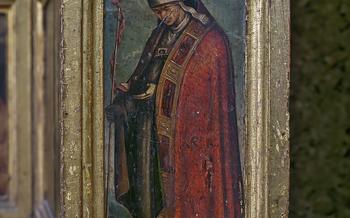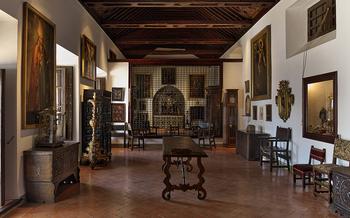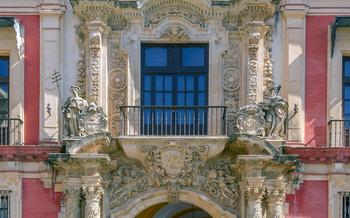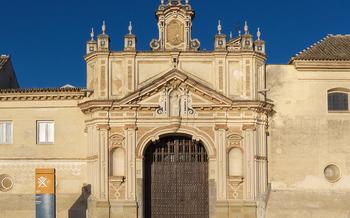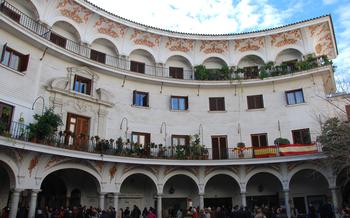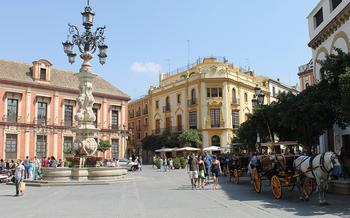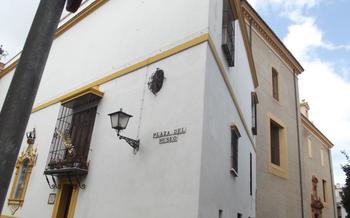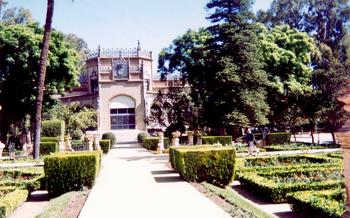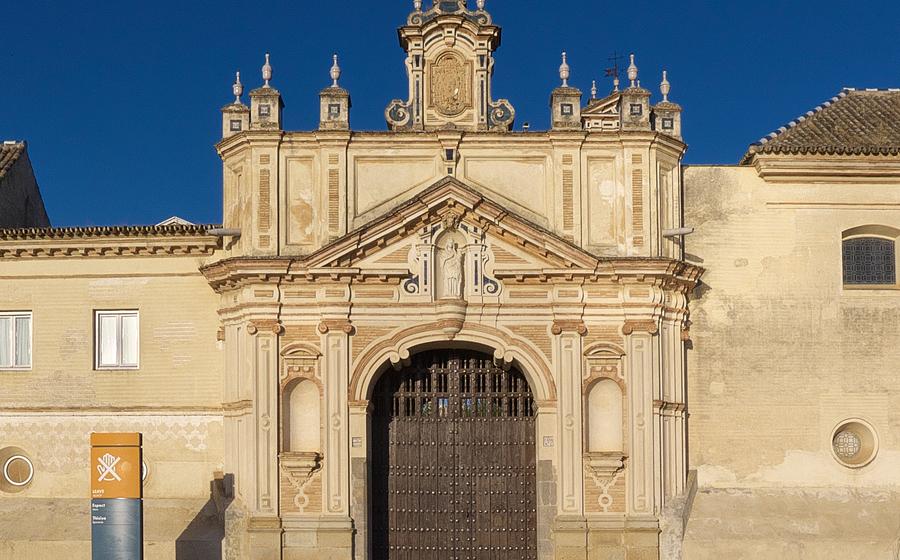
Monasterio de la Cartuja
- A Journey Through Time: Historical Overview
- Architectural Masterpiece: Exploring the Monastery's Design
- A Walk Through the Cloisters: A Peaceful Oasis
- The Church of the Monasterio: A Showcase of Gothic Grandeur
- Exploring the Museum: A Treasure Trove of Art and History
- A Place of Reflection and Spirituality: The Carthusian Order
- The Cartuja Gardens: A Serene Retreat
- The Courtyard of the Oranges: A Citrus-Scented Haven
- Amidst the grandeur of the Monasterio de la Cartuja, a hidden gem awaits—the Courtyard of the Oranges. This serene oasis, tucked away within the monastery's walls, offers a fragrant escape and a glimpse into the tranquil life of the Carthusian monks.
- The courtyard, as its name suggests, is adorned with neatly arranged orange trees, their glossy leaves shimmering under the warm Andalusian sun. The air is filled with the sweet aroma of citrus blossoms, creating a sensory experience that transports visitors to a realm of tranquility.
- The courtyard serves as a place of contemplation and relaxation for the monks, who would gather here to seek solace and find inspiration in the beauty of nature. The orange trees, with their vibrant colors and delicate fragrance, symbolize purity, joy, and renewal, embodying the spiritual essence of the Carthusian Order.
- The Courtyard of the Oranges has also played a significant role in the monastery's history. It was here that the monks would gather to discuss important matters, make decisions, and conduct their daily business. The courtyard's serene atmosphere provided a conducive space for contemplation and reflection, allowing the monks to make informed choices in accordance with their religious principles.
- Visitors to the Monasterio de la Cartuja are encouraged to take a moment to pause and savor the tranquility of the Courtyard of the Oranges. Whether seeking a moment of respite from the bustling city or simply wanting to immerse themselves in the monastery's rich history, this hidden gem offers a unique and unforgettable experience.
- The Chapel of San Bruno: A Touch of Simplicity
- The Sacristy: A Display of Artistic Treasures
- The Library: A Repository of Knowledge
- Visiting the Monasterio de la Cartuja: Practical Information
- Insider Tip: Discovering Hidden Gems
A Journey Through Time: Historical Overview
The Monasterio de la Cartuja was founded in 1399 by Don Gonzalo Mariño, a wealthy nobleman and Lord of Dos Hermanas. Inspired by the Carthusian Order's strict adherence to the monastic life, he donated land on the outskirts of Seville for the construction of the monastery.
The Carthusian Order, known for its devotion to solitude and contemplation, played a significant role in the religious and cultural landscape of Seville. The monks followed a rigorous daily routine centered around prayer, work, and silence, which allowed them to achieve a deep connection with God.
Throughout its history, the monastery witnessed numerous historical events and hosted notable figures. In the 15th century, King Juan II of Castile granted the monastery royal patronage, solidifying its status as a prestigious religious institution.
During the 19th century, the monastery faced significant challenges. In 1810, French troops occupied Seville and looted the monastery, causing extensive damage to its artwork and architecture. In 1836, the Spanish government confiscated the monastery's land and properties, leading to its abandonment.
In 1841, the monastery was declared a national monument, and restoration efforts began. The restoration process was lengthy and complex, but it eventually resulted in the monastery's revival as a cultural and historical landmark. Today, the Monasterio de la Cartuja stands as a testament to the resilience of the human spirit and the enduring power of faith.
Architectural Masterpiece: Exploring the Monastery's Design
The Monasterio de la Cartuja stands as a testament to the grandeur and elegance of the Gothic-Mudejar architectural style. Its exterior boasts intricate brickwork and decorative elements, showcasing the harmonious blend of Christian and Islamic influences. The monastery's facade features a striking portal adorned with elaborate carvings and sculptures, inviting visitors to step into its sacred space.
Upon entering the monastery, one is immediately struck by the soaring arches and ribbed vaults that define the interior. The church, the heart of the monastery, is a masterpiece of Gothic architecture, with its intricate altarpiece, stained glass windows, and beautifully carved choir stalls. The cloisters, with their peaceful ambiance and serene atmosphere, provide a contemplative space for reflection and meditation.
Other notable features of the monastery's design include the chapter house, with its impressive collection of paintings, and the sacristy, which houses a treasure trove of religious artifacts and artwork. The refectory, where the monks once gathered for communal meals, is another architectural highlight, with its long tables and vaulted ceiling.
Every corner of the Monasterio de la Cartuja reveals the meticulous attention to detail and the artistic mastery of its creators. Its architectural design is a testament to the enduring legacy of the Carthusian Order and the cultural heritage of Seville.
A Walk Through the Cloisters: A Peaceful Oasis
The cloisters of the Monasterio de la Cartuja offer a serene respite from the bustling city, inviting visitors to immerse themselves in a tranquil oasis. Arranged around a central courtyard, the cloisters feature elegant arches supported by slender columns, creating a sense of lightness and openness. The intricate tilework adorning the arches and walls adds a vibrant touch, capturing the essence of Andalusian artistry.
As you stroll through the cloisters, the peaceful atmosphere envelops you, encouraging contemplation and introspection. The soft echoes of footsteps and the gentle rustling of leaves create a soothing ambiance, inviting you to slow down and savor the moment. The integration of nature within the cloisters is a testament to the Carthusians' deep appreciation for the harmony between the spiritual and the natural world.
Take a moment to sit on one of the benches nestled within the cloisters and simply absorb the tranquility. Let your gaze wander over the intricate details of the architecture, from the delicate carvings on the capitals to the intricate patterns of the tiles. Allow the serenity of the space to wash over you, leaving you feeling refreshed and rejuvenated.
The Church of the Monasterio: A Showcase of Gothic Grandeur
The church of the Monasterio de la Cartuja stands as a testament to the grandeur of Gothic architecture. Constructed in the 15th century, the church's exterior features intricate carvings and delicate tracery, showcasing the skill and artistry of its builders. Inside, visitors are greeted by a sense of awe as they gaze upon the soaring vaults, ornate stained-glass windows, and elaborate altarpiece.
The main altarpiece, a masterpiece of Gothic art, is a sight to behold. Its intricate carvings depict scenes from the life of Jesus Christ and the Virgin Mary, accompanied by a vibrant array of colors. The choir stalls, with their finely carved wooden seats and elaborate canopies, add to the church's grandeur.
The stained-glass windows, with their rich hues and intricate patterns, cast a kaleidoscope of colors onto the church's interior, creating a mystical and ethereal atmosphere. Each window tells a story from the Bible or the life of a saint, inviting visitors to contemplate their religious significance.
The church of the Monasterio de la Cartuja is not just a place of worship but also a repository of artistic treasures. Its interior is adorned with paintings, sculptures, and other works of art that showcase the talent and devotion of the Carthusian monks.
This sacred space has witnessed numerous historical events and has been associated with prominent figures throughout the centuries. It served as the burial place for several members of the Spanish nobility, and its walls have echoed with the prayers and chants of countless monks over the years.
The church of the Monasterio de la Cartuja remains a living testament to the enduring power of faith and the artistic genius of the Gothic era, inviting visitors to step back in time and experience the majesty of this sacred space.
Exploring the Museum: A Treasure Trove of Art and History
The Monasterio de la Cartuja houses a remarkable museum that showcases a treasure trove of art and history. The museum's collection spans centuries, offering visitors a glimpse into the rich artistic and cultural heritage of the monastery and the Carthusian Order.
Among the highlights of the museum's collection are stunning paintings by renowned artists, including Francisco de Zurbarán, who is celebrated for his masterful depictions of religious scenes. Visitors can marvel at the intricate details and vivid colors of Zurbarán's works, which capture the essence of the Carthusian spirituality and way of life.
In addition to paintings, the museum also displays a variety of sculptures, religious artifacts, and other objects that provide insights into the history and traditions of the Carthusian Order. These include intricately carved wooden sculptures, precious metalwork, and illuminated manuscripts that showcase the artistic skills and craftsmanship of the Carthusian monks.
The museum's collection is not only aesthetically pleasing but also holds historical and religious significance. Many of the artworks and artifacts have been meticulously preserved and restored, offering visitors a tangible connection to the past and allowing them to appreciate the rich legacy of the Monasterio de la Cartuja.
A Place of Reflection and Spirituality: The Carthusian Order
Founded in the 11th century by Saint Bruno, the Carthusian Order is a Roman Catholic religious order known for its strict adherence to a contemplative and solitary lifestyle. The order's name is derived from the Grande Chartreuse, the motherhouse of the Carthusians, located in the French Alps near Grenoble.
The Carthusian way of life is centered around prayer, silence, and solitude. Monks live in individual cells, where they spend much of their time in contemplation and study. They come together for communal prayer in the church and for meals in the refectory, but otherwise maintain a life of solitude and silence.
The Monasterio de la Cartuja in Seville was a significant center of the Carthusian Order in Spain. Founded in the 15th century, the monastery provided a secluded retreat for monks to pursue their spiritual calling. The Carthusian monks played an important role in the religious and cultural life of Seville, contributing to the city's rich artistic and intellectual heritage.
One of the most intriguing aspects of the Carthusian Order is their unique approach to spirituality. The monks believe that true spiritual growth can only be achieved through solitude and silence. By withdrawing from the distractions of the world, they seek to create a space for deep contemplation and communion with God.
There are many anecdotes and stories about the Carthusian monks that illustrate their dedication to their way of life. One story tells of a monk who was so absorbed in his prayers that he remained motionless for several days, unaware of the passage of time. Another story tells of a monk who, after spending many years in solitude, emerged from his cell with a profound understanding of the divine.
The Carthusian Order continues to play an important role in the Catholic Church today. Although their numbers are relatively small, the Carthusians remain committed to their unique way of life, preserving a tradition of contemplation and spirituality that has endured for centuries.
The Cartuja Gardens: A Serene Retreat
Nestled within the grounds of the Monasterio de la Cartuja, visitors will find a hidden gem—the Cartuja Gardens. This tranquil oasis, once a private retreat for the Carthusian monks, now invites visitors to immerse themselves in its serene beauty.
The gardens are a testament to the monks' love of nature and their dedication to creating a peaceful environment conducive to contemplation and prayer. Meandering paths wind through the lush greenery, leading visitors past vibrant flowerbeds, towering trees, and tranquil water features.
The gardens are particularly renowned for their collection of orange trees, which fill the air with a sweet citrus scent, especially during the spring blossom. The vibrant colors and delicate fragrances create a magical atmosphere that transports visitors to a world of tranquility.
The Cartuja Gardens offer a welcome respite from the hustle and bustle of city life. Visitors can wander at their own pace, enjoying the peace and solitude, or simply sit beneath a shady tree and soak up the serene atmosphere.
Whether you're seeking a place to relax and unwind, or simply appreciate the beauty of nature, the Cartuja Gardens are a hidden gem not to be missed.
The Courtyard of the Oranges: A Citrus-Scented Haven
Amidst the grandeur of the Monasterio de la Cartuja, a hidden gem awaits—the Courtyard of the Oranges. This serene oasis, tucked away within the monastery's walls, offers a fragrant escape and a glimpse into the tranquil life of the Carthusian monks.
The courtyard, as its name suggests, is adorned with neatly arranged orange trees, their glossy leaves shimmering under the warm Andalusian sun. The air is filled with the sweet aroma of citrus blossoms, creating a sensory experience that transports visitors to a realm of tranquility.
The courtyard serves as a place of contemplation and relaxation for the monks, who would gather here to seek solace and find inspiration in the beauty of nature. The orange trees, with their vibrant colors and delicate fragrance, symbolize purity, joy, and renewal, embodying the spiritual essence of the Carthusian Order.
The Courtyard of the Oranges has also played a significant role in the monastery's history. It was here that the monks would gather to discuss important matters, make decisions, and conduct their daily business. The courtyard's serene atmosphere provided a conducive space for contemplation and reflection, allowing the monks to make informed choices in accordance with their religious principles.
Visitors to the Monasterio de la Cartuja are encouraged to take a moment to pause and savor the tranquility of the Courtyard of the Oranges. Whether seeking a moment of respite from the bustling city or simply wanting to immerse themselves in the monastery's rich history, this hidden gem offers a unique and unforgettable experience.
The Chapel of San Bruno: A Touch of Simplicity
Amidst the grandeur as a testament to the simplicity and devotion that characterized the Carthusian Order. Dedicated to the founder of the order, Saint Bruno of Cologne, the chapel exudes an air of tranquility and humility.
The chapel's architectural style is characterized by its unadorned facade and modest interior. The exterior features simple lines and a rectangular shape, devoid of elaborate ornamentation. Inside, the chapel is equally austere, with whitewashed walls, a wooden ceiling, and a stone floor.
The main attraction of the chapel is the statue of San Bruno, which occupies a central position in the altarpiece. Carved from wood and painted in vibrant colors, the statue depicts the saint in his characteristic pose, holding a book and gazing contemplatively.
The simplicity of the chapel's design is a reflection of the Carthusian emphasis on humility and detachment from worldly possessions. For the Carthusians, the chapel was a place for solitary prayer and communion with God, where they could seek spiritual enlightenment and purification.
One anecdote related to the chapel tells of a young monk who was so devoted to San Bruno that he spent hours each day in the chapel, praying and meditating. One night, as he was kneeling before the statue, he had a vision of San Bruno, who smiled at him and blessed him. The monk was so overcome with emotion that he burst into tears and vowed to dedicate his life to serving God.
The Chapel of San Bruno is a poignant reminder of the spiritual journey undertaken by the Carthusian monks. Its simplicity and devotion create a serene and contemplative atmosphere, inviting visitors to reflect on their own spiritual paths and seek inner peace.
The Sacristy: A Display of Artistic Treasures
The sacristy of the Monasterio de la Cartuja is a treasure trove of artistic and religious artifacts. This sacred space is where the monks kept their vestments, sacred vessels, and other liturgical objects. It is adorned with intricate carvings, paintings, and sculptures that depict scenes from the Bible and the lives of the saints.
One of the highlights of the sacristy is the 16th-century altarpiece, which features a stunning depiction of the Last Supper. The altarpiece is made of wood and is intricately carved with scenes from the life of Christ. It is a masterpiece of Renaissance art and is considered one of the most important works of art in the monastery.
Another notable feature of the sacristy is the collection of silverwork. The monks of the Carthusian Order were skilled silversmiths, and the sacristy is home to a number of their exquisite creations. These include chalices, monstrances, and processional crosses, all of which are beautifully crafted and decorated with intricate designs.
The sacristy also houses a collection of paintings by some of the most renowned artists of the Spanish Golden Age. These include works by Francisco de Zurbarán, Bartolomé Esteban Murillo, and Juan de Valdés Leal. The paintings depict religious scenes and figures, and they are a testament to the artistic and cultural significance of the monastery.
Visiting the sacristy of the Monasterio de la Cartuja is a must for anyone interested in art, history, or religion. This sacred space is a treasure trove of artistic and religious artifacts, and it oferece a glimpse into the rich history and cultural heritage of the monastery.
The Library: A Repository of Knowledge
The Monasterio de la Cartuja boasts an impressive library, a testament to the Carthusian Order's emphasis on education and scholarship. This serene space holds a wealth of knowledge, with a collection that spans various subjects, including theology, philosophy, history, and literature. The library's holdings are not only extensive but also historically significant, containing rare and ancient manuscripts, some dating back to the Middle Ages.
The library's atmosphere is one of reverence and contemplation, conducive to study and reflection. Visitors can admire the beautiful architecture of the space, with its vaulted ceilings, ornate woodwork, and stained-glass windows that filter in a soft, warm light. The library also features a collection of stunning frescoes and paintings, adding to its artistic and cultural value.
While the library is primarily intended for use by the Carthusian monks, it is sometimes open to the public for research purposes. Visitors interested in exploring this treasure trove of knowledge should inquire about access and availability. The library's collection offers a fascinating glimpse into the intellectual pursuits of the Carthusian Order and the broader history of scholarship in Seville.
Visiting the Monasterio de la Cartuja: Practical Information
**Hours open to the public from Tuesday to Sunday, with varying hours depending on the season. Admission fees are typically charged, with discounts available for students, seniors, and groups. It's advisable to check the official website or contact the monastery directly for the most up-to-date information on hours and fees.
Guided Tours and Self-Guided Exploration:
Guided tours are offered in various languages, providing a deeper insight into the history, architecture, and significance of the monastery. These tours are led by knowledgeable guides who can answer questions and share fascinating anecdotes. Alternatively, visitors can opt for self-guided exploration, allowing them to wander at their own pace and soak in the tranquil atmosphere of the monastery.
Accessibility and Facilities for Visitors:
The Monasterio de la Cartuja is wheelchair accessible, with ramps and elevators provided for easy movement throughout the complex. Restrooms, a gift shop, and a small café are also available within the premises, ensuring a comfortable and enjoyable visit for all guests.
Tips for Planning Your Visit:
To make the most of your visit, consider the following tips:
- Arrive early to avoid crowds and enjoy a more peaceful experience.
- Wear comfortable shoes as there's a fair amount of walking involved.
- Photography is allowed, but using a flash is prohibited to preserve the artwork and artifacts.
- Plan some time to relax in the serene gardens and soak in the tranquil atmosphere.
- Check the monastery's website for special events, exhibitions, or concerts that might be taking place during your visit.
Insider Tip: Discovering Hidden Gems
Beyond the well-trodden paths of the Monasterio de la Cartuja, there are hidden gems waiting to be discovered by discerning travelers. For a truly immersive experience, venture off the beaten track to uncover these secret spots.
One such hidden gem is the Rooftop Terrace, which offers panoramic views of Seville's cityscape, with the Guadalquivir River meandering through the heart of the city. Capture stunning photographs of the terracotta rooftops, the Giralda Tower, and the majestic cathedral from this elevated vantage point.
For a serene and contemplative moment, seek out the Secret Garden, tucked away behind the cloisters. This secluded oasis is a sanctuary of tranquility, where the gentle sound of trickling water and the scent of blooming flowers create a magical atmosphere.
To truly appreciate the monastery's architectural grandeur, visit during the Golden Hour, when the setting sun casts a warm glow on the stone facades, illuminating intricate details and casting long shadows that enhance the monastery's mystique.
Immerse yourself in the local culture by attending one of the many events and festivals held at the monastery throughout the year. These celebrations showcase the rich heritage of Seville and offer a unique opportunity to mingle with locals and experience the vibrant spirit of the city.
